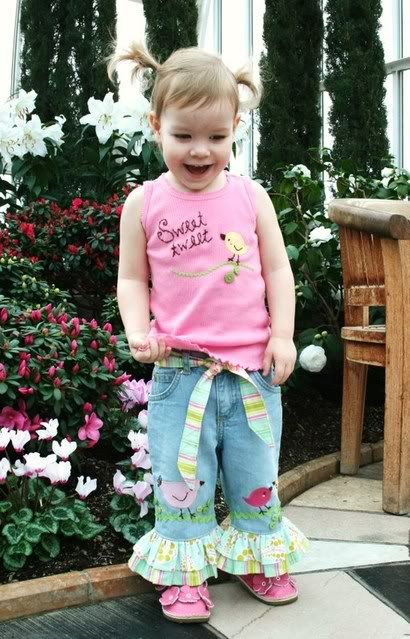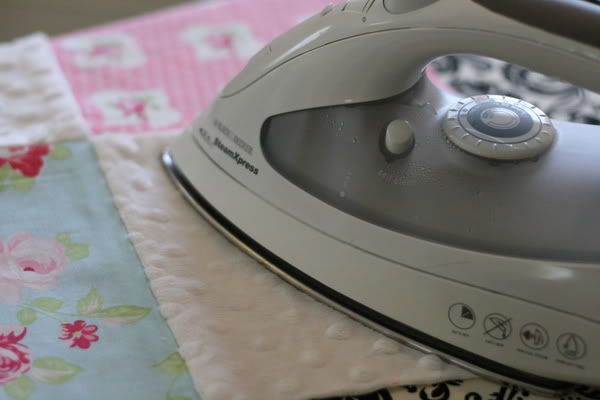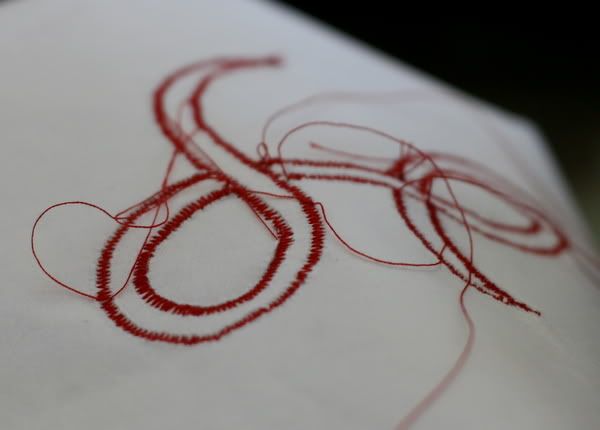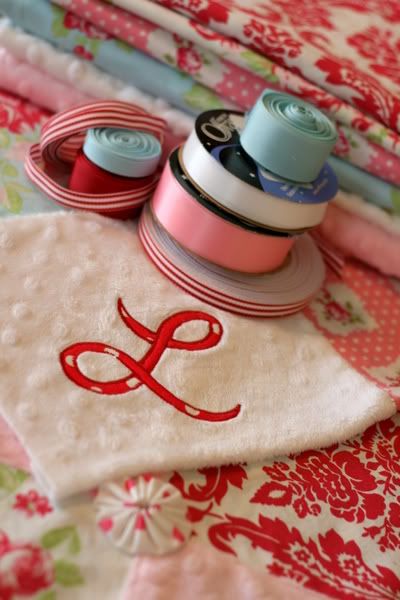Want to learn how to applique?
Then, let's get started with my free tutorial!
You'll need:
- A basic understanding of your sewing machine. How to change from a straight stitch to a zig zag stitch. And how to make that zig zag stitch tight (small) so that the stitches are very close together.
- A drawing for your applique. You can draw it yourself or trace a design from a coloring book or picture.Whatever you like.
- Heat N Bond Lite for attaching the applique to your project. This can be found hanging in the notions section at JoAnn.
- Tear Away Stabilizer if you are sewing on a light weight fabric or knit. Also in the notions section. Make sure it's the iron on kind.
- Fabric and thread to either match or contrast.
- A clear presser foot. How else are you going to be able to see what you're doing?
- Ball point needle. This is only necessary when sewing onto a knit t-shirt, so the needle doesn't make holes in the knit.
When making Boutique clothing I usually draw my appliques from the fabrics themselves. I do it freehand because I love to draw, but I've heard of people actually making photo copies of the fabric, shrinking or blowing it up on a copier and then tracing it. So you don't even have to be able to draw. Anyone can do this!
One thing I've been wanting to try is going to a scrapbook store and using their die cut machines (is that what they are called) to cut out various letter fonts on card stock. They'd make great stencils and be about the right size for clothing or baby blankets.
I outline my drawing with a sharpie pen so that when I flip it over I can still see the design. Or you could also tape it a window and use the light to help draw the reverse on the backside of the paper.
Front (how your finished design will look)
Back (reverse image I will use for making the applique)
Lay a piece of Heat N Bond on top of your drawing. The scratchy surface (adhesive side) down on the paper, the smooth surface (for writing on) facing up.
Trace your image on to the Heat N Bond paper.
Tip: if you are working with a more complicated design (see end of post for examples) you'll need to draw out each piece/color separately. Add on about a 1/4" to an portion that will be layered under another piece so it can be anchored under the outline stitching of the top piece. You don't want to just place them next to each other because you'll have 2 rows of stitching right next to each other. I hope that makes sense. Feel free to ask questions in the comments.
Trim around your design a bit so you don't waste too much fabric. Then position it on the wrong side of your fabric. For this one I tried to get it to hold as many polka dots as possible.
Set your iron to no-steam, and cotton settings. Quickly run your iron over the paper. It only takes a couple of seconds to fuse it to your fabric (you'll hold it down longer when you attach it to your project later.
I like to cut it out and lay it where it's going to go just to make sure it's taking on the look I had envisioned. No point in going further if you are going to change your mind about fabric selection or scale.
Now cut it out fully. Remember learning how to cut out the inside of a circle back in grade school?
Isn't it nice to know that some of that comes in handy later on in life? I loved art class in school. Always my favorite subject.
Remove the paper backing and lay it in place on your project. Hold your iron down (without moving it around) for about 6-9 seconds. Lift it up to see if you have a good seal all the way around. If not, iron for a few more seconds.
*In my example, I had to iron the applique onto minky fabric. It's made of polyester, so you should have your iron on a cooler setting for this. You can read more about minky here.
Voila!
Now, if you are working on a stretchy fabric or a thinner fabric (i.e. not denim), you'll want to put some stabilizer on the back to keep it from getting wonky. I also find that having this more slippery surface underneath makes it easier to maneuver the fabric under your needle since the feed-dogs want to keep it moving in only one direction.
Cut out 2 layers of the Tear Away Stabilizer, a bit bigger than your applique. Iron down each layer separately, with the same settings, for about 6 seconds per layer.

Now you are ready to start sewing.
For applique, practice is really key. The first time I tried it, about 3 years ago, I didn't even have my bobbin installed correctly. It looked horrible! Not to scare you, but just to say that anyone can figure it out.
Since all machines are different I can't really tell you how to adjust your settings. But this is what you are going for. You want to use a zig zag stitch with a stitch width of about an 1/8". Of course you can make it wider or narrower to your liking. But you want to make sure your stitch sits far enough into the fabric that the fabric can't just be ripped out of it.
The next thing you want to do is make the stitch length really short. I usually make mine as short as possible (a satin stitch). For my example here I made it a bit wider so you can see the stitches and so any of the polka dots I had to sew over would show through. That's just personal preference/style though.
I start stitching with the right side of my stitch just barely making it over the right edge of my applique. If you don't go off the edge, the edge of the applique will look like it's frayed, with pieces of the fabric coming through the stitches.
For applique, practice is really key. The first time I tried it, about 3 years ago, I didn't even have my bobbin installed correctly. It looked horrible! Not to scare you, but just to say that anyone can figure it out.
Since all machines are different I can't really tell you how to adjust your settings. But this is what you are going for. You want to use a zig zag stitch with a stitch width of about an 1/8". Of course you can make it wider or narrower to your liking. But you want to make sure your stitch sits far enough into the fabric that the fabric can't just be ripped out of it.
The next thing you want to do is make the stitch length really short. I usually make mine as short as possible (a satin stitch). For my example here I made it a bit wider so you can see the stitches and so any of the polka dots I had to sew over would show through. That's just personal preference/style though.
I start stitching with the right side of my stitch just barely making it over the right edge of my applique. If you don't go off the edge, the edge of the applique will look like it's frayed, with pieces of the fabric coming through the stitches.

I also do a back-stitch as I start and stop each section. This helps secure the threads so they don't unravel. I'll show you later how to tie off all the ends.
See how easy it is to see what I'm doing with my clear presser foot? I've done it without, but it was a nightmare.
See how easy it is to see what I'm doing with my clear presser foot? I've done it without, but it was a nightmare.

I hold my fabric down making a "v" with my fingers. This allows me the most control when guiding the fabric along the outline I am sewing. Having that stabilizer on the backside makes it move much smoother too.

Make a note of where you need to start and stop based on your design. I want the "L" to look like it's hand drawn, with the appropriate sections seeming like they are laying on top. Refer back to your original drawing for queues.

By the time you are finished, you'll have a lot of threads on the top and bottom. Keep them long so you have plenty to work with when you tie them off.

Flip to the backside and start tugging on all the threads. Anything that isn't secured from your back-stitching will yield a little loop from the thread on the opposite side. Just pull it all the way through, so you have two threads that are close together. Tie these together with a triple knot and trim them.
This can get tedious especially if you have a complicated design. It might be easier to do this throughout the process instead of waiting until the end. But try not to skip this step as it really adds to the longevity of your piece. Attention to detail. This is something that mass-produced clothing does not do. Ever find a stray thread and pull it only to find the garment/design starts unraveling? So annoying isn't it?
This can get tedious especially if you have a complicated design. It might be easier to do this throughout the process instead of waiting until the end. But try not to skip this step as it really adds to the longevity of your piece. Attention to detail. This is something that mass-produced clothing does not do. Ever find a stray thread and pull it only to find the garment/design starts unraveling? So annoying isn't it?

See the tiny loop in the middle of this next photo? I got that by pulling on the thread right there. That's the thread from the top side coming back through with the one I pulled on. If you didn't pull it all the way to the back and tie it off, your applique could start unraveling in that spot.

Flip it back over and gently pull up the stabilizer, one layer at a time, tearing it at the stitching. Remove it from the center of your stitching too. You can use a pin or the point of your seam ripper to get it loosened.
Need some inspiration? Here are some of my past appliqued Boutique clothing.

For this one I just traced the lemons from the fabric itself.

This was all free-hand drawn to copy the fabric. It was a lot of fun to draw.

This tree was actually quite labor intensive with all those points.
I ended up making a bunch of them.
I'm crazy like that.
I ended up making a bunch of them.
I'm crazy like that.


Who doesn't love a cute sock monkey? Seriously!
I'm making these again for the girls. They were so cute to wear to the Zoo.

This was for a collection I made using fabrics by Anna Maria Horner called Chocolate Lollipop. There weren't actually lollipops in her prints, but I decided to do a literal take on the name and drew up this fun applique. There ended up being 5 layers of applique (plus the denim) to so sew through. Next time I would remove some of the center from the brown and aqua layers to get rid of some of that bulk.

This last one is so simple. A scrap of fabric and the face is cut right from the fabric itself. I drew the letter, but letter stencils would make that easier.

Now go applique something!




















36 comments:
Oh my! Oh my! Oh my! You are one very talented cookie, Angel!
Great job! I love all your clothes...can't wait to see them up for auction again!!
Thanks for the tute! Always wanted to learn the proper way to applique! The closest I ever got was sorority letters in college :) When my mom was teaching me to sew (still is :) she made me pull all those tiny threads through to the other side and tie them off. Said it was the proper finishing touch for a garment. Such a pain to do that! I actually thought she made it up...but I stand corrected :) Ha, Ha!
Ditto Kacey's comment :)
Wow! Very cute! I love your "little" model too! Some seriously fun clothes!
thanks for sharing,
Jody
Thank you so much for this! I have always wanted to try it, but it seems way too complicated. You made it sound pretty simple, so I'd love to give it a try one day.
And art class was always my favorite too : )
Thanks for checking out my tutorial. Next on the list is "How to Hand Embroider." My favorite!
Great tutorial! Can't wait to do this!
Adorable! Now I see what I've been doing wrong...
You are so talented! Your applique is ahhh-may-zing! I absolutely *love* the sock monkey shirt! :)
mommyoftwo247.blogspot.com
I love how detailed and helpful this tutorial is! Quick question, do you have to use a specific type of thread for this?
Nope, you don't need special thread for this. I use the same thread I sew with. But I have switched away from Coats and Clark and started using Gutermann because it leaves you machine less gunked up with lint.
You could certainly use the shiny embroidery thread that you use in a computerized embroidery machine, but it's quite expensive so I haven't done that yet. But it may be worth it if you only need one color, it does look nice on a finished project. I tend to use many colors with my more involved appliques so that would cost me an arm and a leg.
Have fun!
Been looking for an applique tute for awhile. Thanks this helps. Few questions later on but thats when I get going
wow - you have the cutest children and clothes i have ever seen!!!!! Adorable! Love your designs and tutorial. One qq- I always just set my machine to straight stitch and sew a locking stitch and then start the applique over it and end it- no tying and unraveling. I love the Lord also !
Thanks for the sweet comments Liza! You brightened my day. :)
I do a locking stitch at the beginning too, but at the end I'm just not convinced it's enough to hold it. When I pull on the thread from underneath, the top one still want to pull through, so I just tie it off. I figure I'm better safe than sorry, especially after doing all that work.
I just love your blog. Thank you for the great tutorials. Your girls are darling. I have 2 great granddaughters both under 2 years old I have to try some of the applique pants so cute.. Thanks again Jude in SO CA
thank you so much for tutorial wish I'd seen before I did this method on minky just like you but iron was too hot and it flattened out bubbles. I didn't know!! Also a clear presser foot was a must for me as I couldn't see my stitching without it. I couldn't pull the threads through, had to put in needle and 'sew' to back. nice to know most of my guessing was right. thanks again
Thanks for the tips!! I have done applique, and I sew with Minky...but I haven't done applique of minky on minky - any tips? I want to make some PJ pants in spa minky with a minky applique on the bottom, and I'm a little scared!
Another idea for applique shapes you might like is to find someone with a Cricut machine. they're home digital di-cut machines and some of the designs are actually layerable. Many more choices than the old style di-cuts that scrapbook stores do.
Hi Jorie,
I haven't appliqued minky on minky yet, but my advice would be to not over iron as you go. Depending on the brand you are using, some have a lower melting point than others. You can also place one layer of a cotton fabric on top of what you are ironing to give it more of a buffer from the hot iron. Good luck!
Great tutorial! I am a technical editor, and I would hire you as a writer in a minute. Your explanation is really clear and your illustrations are excellent! I have a quick question: I am using applique to create eyes on a large stuffed animal. The animal is minky, and the eyes will be satin. Do you have any suggestions for the white highlight in the eye? I'm not sure if I should try to machine embroider it (it's about a perfect circle) or try to do it by hand. Any other ideas would be welcome. Thanks!
Angel, I used your tutorial to make a pillow. I love the way it turned out. Here it is:
http://susan-anyway.blogspot.com/2012/01/my-first-appliqued-pillow_18.html
Thanks!
How do you do the points, like in the tree, etc.?
Ashley, you do a lot of lifting your presser foot and pivoting. I usually do those corners with my foot off the presser foot and just hand-crank each stitch so I can get the needle to go exactly where I need it too. Practice makes perfect.
Thank you so much for all of your wonderful designs. You are an inspiration and girl you are so talented. I sew for my granddaughters and can't wait to try some of your things,especially the applique. Please keep sewing.
Thanks for the tutorial on the appliqué. I am going to try now. I will post a link later so that you can see how well your tutorial works!!
I have a problem with curves. I can never seem to follow the line of my fabric. Is that where the clear foot comes in to play?
I have trouble with the inside curves. I just can't seem to follow my fabric line. Is that where the clear foot comes in to play?
Cindy, yep the clear foot is a must. it's incredibly difficult without it. On the curves, go slow and if you can't turn the fabric well enough through the curve then every little bit stop, lift your foot and rotate a smidge then keep going.
Gorgeous!! You have mastered the stitch………….
Embroidery Digitizing Service
A little late adding to the comments but I saw this tutorial on Pinterest and wanted to compare techniques. You do a great job explaining how to do manual applique with an embroidered stitch look. May I add that using a bobbin thread of white (or the fabric color) really helps to blend the design on the bottom. That's something I hate about true machine applique and embroidery but a nice perk to doing applique by hand. Well done!
Your tutorial is seriously awesome. I went step by step and actually did it! Two gorgeous applique patches in 30 minutes! You have a gift for instruction. Thanks a million. I'm going to resuscitate my grandmom's hand-embroidered pieces for my baby's keepsakes.
What a great tutorial! Thanks for sharing...I'm going to put this to good use tomorrow!
Thank you SO much for this tutorial! I've been a seamstress for a long time, and I, too, love making appliques. I want to make a baby blanket from minky, and applique the baby's name with cotton fabric letters. However, I've never worked with minky, and was quite apprehensive to iron the applique onto it, due to fabric melting horror stories I've read. Thanks to your tutorial, I'm jumping in and stitching away without fear! ;) (And oh my goodness -- your boutique designs are stunning!)
Thank you for the tutorial for the applique on the minky. I have an order to finish really quick and have never sewn on minky before and already messed up one block by pressing appliques too hot and ruining the bumps.
Judy in Texas
this may be a silly question, but is cotton considered a "light" weight fabric? I'm trying to decide whether I will need to buy the tear away stabilizer if I am applying an applique on cotton fabric.
R.bradley, yes, I consider cotton a lightweight fabric. I always use tear away stabilizer on the back of just quilter's weight cotton. I actually use it on the back of denim too, because it helps it glide better as I'm turning the fabric. Also, some jeans have some stretch to them so stabilizer also keeps them from stretching while you stitch. Hope that helps!
Love the tutorial, thank you. I have had problems with the needle gumming up when I stitch through the layers with the fusible product. any suggestions?
Cathy January 2017
Post a Comment